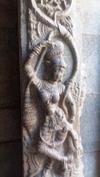
Custom Search
A Beautiful Morning at Lepakshi
by Lakshmi Menon
(Bangalore, India)

It was a holiday on the 14th of January, and we decided to go on a long drive. We had three destinations in mind but finally settled on Lepakshi, a small village in Andhra Pradesh near the Karnataka-Andhra border. Lepakshi is famous for an ancient temple and a colossal monument of Nandi.
We left by 7 a.m. on a foggy morning, and it was a pleasant and refreshing drive. We had our breakfast on the way at Udupi Swaad, a neat restaurant in Devanahalli and continued our journey through the Bangalore-Hyderabad road. As directed by the GPS we turned towards Lepakshi where we saw ‘Welcome to Lepakshi’ board. After a drive of about 16-17 kms through that road, we reached the place where the magnificent statue of Nandi is seen, by 10.45 a.m. The monument is made out of single granite, measuring 4.5 m in height and 8.23 m in length, with finely carved ornaments.
After clicking few snaps, we drove towards the famous Lepakashi temple, about 1 km away from there. The actual name for this is Veerabhadra Swamy temple. There was ample space for parking.
How did the place get the name? According to the legend, Lepakshi got the name because of the legendary Ramayana. When Ravana kidnapped Rama's beautiful wife Sita, and he was taking her away from Panchvati, the fierce bird Jatayu attacked Ravana in an attempt to save her from his hand, but Ravana defeated him, and the bird fell on the floor. As he was counting his last breathe Lord Rama helped him attain Moksha by saying 'Le Pakshi' which in Telugu means 'Rise Bird.' Hence the place got the name Lepakshi.
A visit to this temple is a delight for art lovers, especially the temple architecture. This ancient temple was built on a rocky hill in the 16th century during the period of Vijayanagar kings. The temples of Veerabhadra, Papanatheswara, Raghunatha, Srirama and Devi Durga are located in the same complex on the hillock named as Kurma Saila (tortoise shaped hill).
Since we reached before 11 a.m. it was pleasant to walk around; otherwise, usually this place is sweltering, and walking around would have been little difficult.
There are about 70 pillars at this ancient temple, and one of them does not rest on the ground thoroughly. Lepakshi is famous for this hanging pillar (Aakaasa Sthamba). It is the best known and a tribute to the engineering experts of the ancient and medieval temple builders of India. However, it is a bit dislodged from its original position because of an unsuccessful attempt of an engineer during the British period, who had tried to move it to find out the secret of its support.
The other highlights of the temple are the finest architecture in Dravidian style and paintings depicting stories from wars, marriage and fascinating tales of the bygone era. You can also see a huge Nagalinga which is said to be the largest Nagalinga in India and Durga Padam which is said to be the footprint of Mata Sita.
Since it was Makara Sankranthi festival on the day of our visit few women were making the beautiful kolam designs on the floor before the temple steps.
Lepakshi saris, the designs carved from the architecture on the pillars, are very famous.
Due to its archaeological and historical significance, Lepakshi attracts a large group of tourists.
On our way back, we had lunch at Nandi Upachar, a vegetarian restaurant at the turning road to Nandi Hills.
Comments for A Beautiful Morning at Lepakshi
|
||
|
||
|
||














